Karagöz
Folk
Plays - Spectacle Plays - Shows
KARAGÖZ
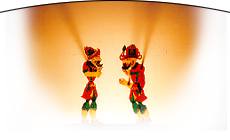 Karagöz
is a shadow play whose true form is the moving of beings named as designs
made from skin of a camel or cow with sticks on a white curtain by reflecting
light behind them. The play takes its name from its main character “Karagöz”.
Karagöz
is a shadow play whose true form is the moving of beings named as designs
made from skin of a camel or cow with sticks on a white curtain by reflecting
light behind them. The play takes its name from its main character “Karagöz”.
The source of
shadow plays is accepted as southeastern Asian countries. There are different
views about it coming to Türkiye. One of the views is that the plays such as
“ember armlet” and “dream tent” known in Middle East are shadow plays and
they’ve been brought to Anatolia during migrations. Other view is that the
shadow play has come into Türkiye after Yavuz Sultan Selim, who had conquered
Egypt in 1517, had brought the shadow play artists to Türkiye.
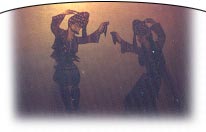 Karagöz
had become one of the most enjoyed entertainment methods of public, which
mainly focused on public types beginning from the 18th century.
Karagöz is played depending on the talent of an artist. Moving the design
on curtain, voicing them, dialects or imitations are all made by the artist.
Karagöz
had become one of the most enjoyed entertainment methods of public, which
mainly focused on public types beginning from the 18th century.
Karagöz is played depending on the talent of an artist. Moving the design
on curtain, voicing them, dialects or imitations are all made by the artist.
The subjects
of Karagöz plays are funny elements. Double meanings, exaggerations, verbal
plays, imitating accents are the main elements of the comedy.
1. The
beginning section in which Hacivat comes to the curtain singing semai and
Karagöz’s calling him after saying a lyric poem and in which Karagöz and hacivat
quarrel is called “Mukaddime”. In this section, the play’s philosophical and
Islamic mysticism and showing the realities are underlined by the lyric poem
Hacivat said.
2. In
the “muhavere” section, there’s a one-to-one conversation apart from the series
of events based only on word of Karagöz and Hacivat. Muhavere may be in rigmarole.
In this section the personal characteristics and opposite natures of Karagöz
and Hacivat are underlined. Muhaveres may both be related or not be related
to the play. Besides there are Muhavere with double Karagözs inconstant muhavere
or middle muhavere types.
3. The
section where the story is mainly expressed and the other characters come
on the curtain is the “fasıl” section. The play takes its title according
to the subject of this section. The players leave the curtain in any way toward
the end of the play. Only Hacivat and Karagöz remain on the curtain.
4. At
the ending part of the play, the ending is informed with the conversation
of Karagöz and Hacivat and apologies are made for any mistakes of the event
to the spectators and the announcement of the following game is made and the
play ends.
In Karagöz play,
there’s satire and irony. These ironies may reach to the state administrators
with a humorous style.
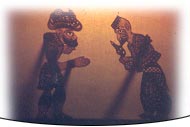 The
main characters of the play are Karagöz and Hacivat. Karagöz represents the
public’s morals and common sense. He speaks as he is. Hacivat is educated
in Moslem theology school and he’s unreliable and following the order. The
other characters are Tuzsuz (Salties) Çelebi, Drunk, Baberuhi, Albanian, Jewish,
Circassian, Kurdish, Laz, Addictive, males taking female parts etc.
The
main characters of the play are Karagöz and Hacivat. Karagöz represents the
public’s morals and common sense. He speaks as he is. Hacivat is educated
in Moslem theology school and he’s unreliable and following the order. The
other characters are Tuzsuz (Salties) Çelebi, Drunk, Baberuhi, Albanian, Jewish,
Circassian, Kurdish, Laz, Addictive, males taking female parts etc.
Karagöz was interested
and supported by the Palace. Karagöz had took place in the festivals and circumcision
ceremonies of princes.
Karagöz is especially
integrated with the Istanbul centered Ottoman culture. It is possible to see
the life of Istanbul in Karagöz plays. Aghas, Great Marriage, Boat and Tahmis
are Ferhad and Şirin, Fisher, Leila and Majnun, Wrong Marriage Tahir and Zühre,
Yalova Pleasure, Karagöz’s Clerkship, Karagöz’s Love, Karagöz’s doctorate
etc.
The Technique
of Karagöz
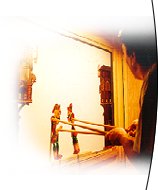 The
white curtain on which Karagöz is played is named as “mirror”. At first the
curtains were 2x2.5 m. then they began to be made in 110x80 m. size. In the
inner side, below the curtain there is an “edging wood”. There are also cymbals,
tambourines, canes, pipes and lamps to illuminate the curtain. These are on
the edging wood. The designs used in the play are 32-40cm sized and they are
generally made from the skin of camel or cows. The skins are made transparent
with a special method. Then they are embroidered with sharp painted blades
called “nevregan”. The pieces are tied with ropes named rafters or catgut.
Then the designs are painted with Indian ink or root paints.
The
white curtain on which Karagöz is played is named as “mirror”. At first the
curtains were 2x2.5 m. then they began to be made in 110x80 m. size. In the
inner side, below the curtain there is an “edging wood”. There are also cymbals,
tambourines, canes, pipes and lamps to illuminate the curtain. These are on
the edging wood. The designs used in the play are 32-40cm sized and they are
generally made from the skin of camel or cows. The skins are made transparent
with a special method. Then they are embroidered with sharp painted blades
called “nevregan”. The pieces are tied with ropes named rafters or catgut.
Then the designs are painted with Indian ink or root paints.
Karagöz, which
was the most important entertainment of Ottoman period, was played in ramadans,
circumcision feast festivals, coffeehouses and gardens. Karagöz, which is
known to address to social events of the period, criticizing them, were prevalently
played in Istanbul. This was spread to other parts of Anatolia by the artists
going on tours.
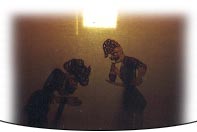 Today,
Karagöz that is one of the most introductory elements of our country are played
in the tourist hotels and restaurants. But spectators generally reach it by
television.
Today,
Karagöz that is one of the most introductory elements of our country are played
in the tourist hotels and restaurants. But spectators generally reach it by
television.
The studies related
to the art of Karagöz that is tried to be continued by a limited number of
artists are conducted by the Presidency of Türkiye National Center of International
Puppet and Shadow Play Union (UNIMA) and the Ministry of Culture.